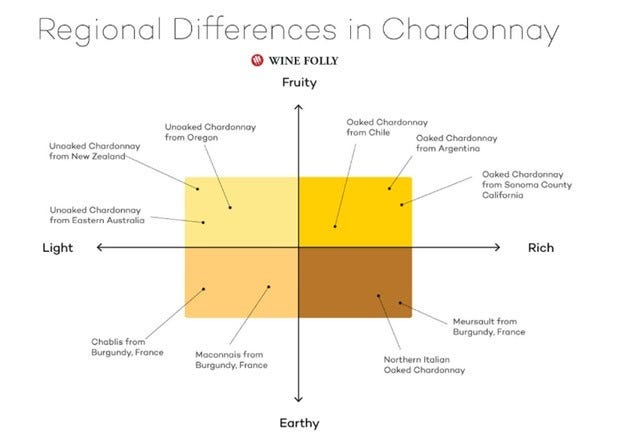Chardonnay: versatile & misjudged!
Did you know that Chardonnay is one of the most adaptable grapes, both in terms of cultivation and winemaking? In fact, it's one of the most widely planted white grapes globally, covering approximately 200,000 hectares of vineyards. It's often referred to as a "blank canvas" because it can be transformed into a variety of styles.
The Wine Folly representation below shows this versatility depending on where it’s grown and how it's crafted. Unoaked, it can be light and fruity or light and minerally (sometimes called "earthy"), while the oaked version becomes full-bodied (often described as "rich").
Source: Wine Folly, https://winefolly.com/tips/3-styles-of-chardonnay-wine-and-how-to-find-them.html
Chardonnay can be a tricky wine to navigate so let’s break it down.
Regional influence on flavor
Chardonnay’s fruit profile can vary depending on the location in which the grapes are grown. For instance, cooler climates such as Canada, or Champagne and Chablis in France, produce Chardonnays with citrusy flavors. In contrast, warmer climates such as southern Italy, most of California, and South Australia tend to produce Chardonnays with peachy or tropical fruit flavors. This latter fruit profile is what some perceive as sweet, even though there may be minimal residual sugar in the wine.
In addition to the fruit, note that European wines (old world) produce wines that also have earthy and minerally flavors. Notice that on the graphic above, non-European wines (new world) only show up above the horizontal axis.
Winemaking’s influence on flavor and texture
Oaked Chardonnays have rich creamy buttery notes which can be polarizing both in terms of the flavor itself but also the texture which feels heavier and more viscous.
Meanwhile, unoaked Chardonnays will taste lighter and crisper. For example, Chablis is 100% Chardonnay by law and produces some fantastic unoaked versions. And let's not forget about Champagne and sparkling wines! Many traditional method sparkling wines contain Chardonnay, some made with 100% Chardonnay grapes (known as Blanc de Blancs).
So do not give up on Chardonnay just yet. With so many different regions and styles to explore, there is sure to be a Chardonnay out there that you'll love. Happy exploring!




